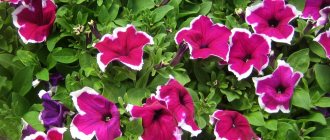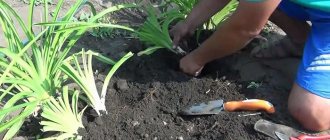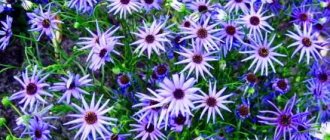Author: Tamara Altova. 01 September 2018
Category: Garden plants.
Godetia (lat. Godetia) is a genus of herbaceous annuals of the fireweed family, common in South and North America. There are about 20 species in the genus. The genus received its name in honor of the famous botanist from Switzerland C.H. Godet, who was the first to describe this plant. Godetia's well-known relatives include fireweed and clarkia. This flower appeared in European gardens in the 19th century, and immediately became popular among both professionals and amateurs.
Types of godetia and popular varieties
Two varieties of godetia have taken root in our gardens - lovely and large-flowered, and in total there are more than 20 species.
As they grow, different varieties can form a compact or rather spreading bush. The flowers of the lovely godetia are not large in size, their diameter is only 4-5 cm. The bushes themselves are tall, weakly branched, with erect stems.
The most popular varieties of this species include:
- Scarlet Red - a variety with deep red flowers and a pink center.
Scarlet red
- Pink Grace (GraceRosePink) is a tall, profusely flowering plant with crimson flowers.
- Satin is a compact plant with bell-like flowers. The color of the petals is pale pink, with crimson strokes in the center.
Large-flowered godetia fully lives up to its name. The diameter of its flowers reaches 10 cm. Bushes of this species are highly branched, but at the same time they are not tall.
There are many more popular varieties of this variety of godetia:
- Satin Rose is a medium height plant. The color of the flowers is predominantly creamy. The edge of the petals is wavy.
- Maiden Blush is a godetia with stunning creamy white flowers with hints of pink at the base of the petals.
- Orange Glory - a plant about half a meter high. Salmon-colored flowers with silky petals.
orange glow
- Memory (Memoria) - godetia of this variety has white flowers with a slightly noticeable pink tint.
- Meteor is a squat bush covered in dark red bells. The petals surprise with their velvety surface.
- Sybil Sherwood is a squat bush with creeping shoots and deep pink flowers.
- Rembrandt - a popular varietal variety with large double flowers. The main color of the petals is pink, with additional purple spots present in the color.
Rembrandt
- Summer's Darling is a compact plant that blooms profusely with burgundy flowers.
Some varieties require a variety of bud colors; in this case, the seed package will be marked “mix.” Within each variety, varieties with double petals are possible. Terry godetia does not exist as a separate botanical species.
Features of godetia
Godetia bushes grow vertically and resemble a pyramid; some are spreading. The shoots are smooth, branched, up to 60 cm long, erect, and can be creeping. At the beginning of summer they are grassy, then they become woody. The leaf blades are bright green, oblong, narrow, pointed at the end, arranged alternately on the stem, 4-10 cm in diameter. The root of the plant is shallow, with small branches. Peduncles are very short.
Bell-shaped or bowl-shaped flowers with a pleasant, rich vanilla aroma. They have 4 petals, which are simple, satin, silk, terry, wavy, one tone or multi-colored. They bloom from July to the end of October. The color is very different: pink, purple, coral, white, red, lilac. They remain open in any weather and do not lose their decorative effect until late autumn. The fruit is a cylinder-shaped capsule with small seeds.
Azaleaceae
When to plant godetia seedlings in 2021
Although the California rose easily tolerates light frosts even at a young age, gardeners prefer to grow it through seedlings to obtain earlier flowering. After all, godetia has a long growing season (80-90 days); for an annual plant, delaying flowering by 2 weeks is an unaffordable luxury.
You should start sowing at home in the last ten days of March. It is advisable to take into account the recommendations of the Lunar calendar. If they are followed, you can expect good seed germination in a short time and increased seedling growth. Favorable days for planting flower crops occur during the waxing phase of the Moon, when the development of the above-ground parts of plants is activated.
Therefore, the following dates will be favorable days for sowing Godetia in 2021 according to the Lunar calendar:
- in March these are the following numbers - 3, 4, from 16 to 18, 22, 23, 26, 30, 31;
- in April - from 7 to 9, 18, 19, from 23 to 26, 28.
In the southern regions, godetia seeds begin to be sown from the third decade of February, since earlier planting in the ground is possible in warm climates. (according to the Lunar calendar, favorable days in February are from 22 to 25 and 28).
Large-flowered
It is the large-flowered varieties that have the most luxurious (up to 10 cm in diameter) godetia flowers. Planting and care (the photo shows large-flowered terry godetia) for these plants are ordinary.
If you follow the recommendations given above in this article, large-flowered godetia varieties will delight you with their beauty from June (using the seedling planting method) until October. The bushes of this species of godetia are different. There are dwarf varieties, for example Feuerkönig, whose flowers are up to 4 cm, red with a white spot, and the bush is only up to 23 cm. There are medium ones - Sybil Sherwood, Rembrandt, Meteor. The height of their bushes is up to 40 cm, the flowers are up to 6 cm in diameter, simple or double, the color of the petals is in red and pink tones. Rembrandt's petals, in addition, are wavy and jagged along the edge.
Tall varieties include Blitzstral with dark red wavy petals and a calyx of flowers up to 6 cm, as well as Orange Room with orange, slightly reddish flowers resembling bells.
Growing godetia from seeds step by step
Godetia is considered unpretentious in care, but can be affected by pests and diseases. Therefore, preliminary preparation of seeds and soil is necessary. After sowing, the seedlings are provided with optimal conditions for growth, so that by the time they are transplanted into the flowerbed, the seedlings are strong and can easily adapt to a new place.
Preparing soil and seeds
A plastic container 15 cm deep is suitable as a container for seedlings. It must be washed and scalded with boiling water for disinfection. If you are going to use soil from your garden for seedlings, heat it in the oven, pour over it with a hot solution of potassium permanganate, or steam it in the microwave.
Disinfection can kill pathogenic microflora. The procedure should be carried out 2-3 days before sowing. In the remaining time, excess moisture will evaporate, and beneficial soil bacteria will have time to multiply. Purchased soil does not need to be processed; this responsibility is assumed by the manufacturer. The soil should have a light structure and allow air and moisture to pass through well.
The seeds will need to be soaked in a solution of potassium permanganate, hydrogen peroxide or any fungicide. For convenience, the seed material is wrapped in gauze and placed in a bowl with a disinfectant. The seeds will need to be pickled for 30 minutes and then rinsed with water. To prevent the seeds from sticking together, they are slightly dried.
Sowing
The sowing process is not particularly difficult and has long been familiar to gardeners. In the case of godetia, you need to act like this:
- A small layer of drainage is poured into the prepared container, followed by the treated soil.
- If the soil is dry, lightly moisten it with a spray bottle and allow the water to be absorbed.
- The seeds are distributed over the surface of the soil at some distance from each other.
- The crops are sprinkled with a thin layer of dry peat on top.
After the work is completed, the container is covered with film and placed in a warm, bright place. The cover is removed when shoots appear, this happens after 1.5-2 weeks.
Caring for godetia seedlings
Godetia seedlings do not tolerate cold air, so they should not be exposed to drafts. Seedlings need moderate watering. The seedlings are moistened as soon as the top layer of soil dries slightly. Water for irrigation is settled; it should be at room temperature or a little warmer. The soil needs to be moistened moderately.
Seedlings are not fertilized before picking. Plants dive at the stage of appearance of the first pair of true leaves. To avoid damage to the roots, seedlings are planted in separate cups along with a lump of earth. After 2 weeks, Godetia can be fed with the complex preparation “Ideal for Flowers”.
On a note! Be careful. Godetia does not tolerate waterlogging and easily rots if overwatered.
When to plant godetia seedlings in open ground
Godetia seedlings are transplanted into open ground in May. Depending on when the sowing was done, planting can be done at the beginning or end of the month. At this point, the bushes should be 5-7 cm high. It is better to choose a dry, cloudy day for work. Transplantation is carried out in the morning so that the young plants can get used to the new place a little during the day.
Try to minimally injure the roots so that the godetia does not hurt in the future. It is better to plant a flowerbed in a sunny, windless place. Loams are most suitable for godetia. Plants must be placed at a distance of 25 cm from each other so that in the future the bushes do not interfere with each other.
Important! You need to have time to transplant godetia into a flowerbed before it produces flower stalks. Flowering plants tolerate this procedure extremely painfully.
How to properly care for godetia in summer
Caring for godetia in open ground is not difficult, but requires regularity. Caring for a plant in the summer includes standard procedures:
- The soil should be loosened regularly between plantings.
- Periodically, the flowerbed will need weeding; weeds are easier to remove after rain or watering.
- Water the California rose regularly, using an average amount of water.
- During the season, plants are fertilized three times with fertilizers for flower crops.
- Buds and old leaves that have dried after flowering are removed.
- The bushes are regularly inspected for pests and the presence of disease symptoms. If necessary, carry out processing.
- For tall varieties, it is recommended to organize support from pegs or rods, since tall stems can break under the weight of flowers.
To keep moisture in the soil longer, you can mulch the flowerbed with sawdust, bark or chopped straw. Godetia likes the soil to always remain slightly moist, but you cannot turn the soil into a swamp, otherwise the plant will get sick.
What to feed for abundant flowering
If godetia is planted in a sunny place and receives regular care, there should be no problems with its flowering. It has been noticed that plants grown in seedlings bloom more luxuriantly. If few buds are formed, try using a special fertilizer that stimulates flowering.
Nitrogen fertilizers are not suitable; they cause the growth of vegetative mass to the detriment of the formation of buds. It is better to use a complete mineral fertilizer intended for summer residents, or nitrophoska in the dosage suggested by the manufacturer.
The most popular drugs include: Agricola, Kemira, Pokon, Master. Each brand produces fertilizers for different stages of growth of flower crops.
To stimulate flowering, you should choose complexes with a predominance of potassium and phosphorus. Such fertilizers are marked on the bottle “For flowering plants” or “For abundant flowering.”
Care and cultivation
This is an extremely unpretentious flower that takes root well in almost any conditions. Regular loamy soil will do; the main thing is to choose a place where the plant will be protected from strong winds and receive enough sunlight. Godetia is quite tolerant of small partial shade, so it can be planted near a house or other buildings.
Features of godetia:
- can bloom before the onset of the first cold weather;
- there is some vulnerability to rain - in damp and cloudy summers the plant weakens and does not bloom as brightly as in sunny and dry ones.
- varieties with tall stems need staking, which must be taken into account when choosing a place and planting conditions;
- does not require active feeding.
Feeding godetia should be treated with special attention - an excess of fertilizers will give active growth, but only to the green part, that is, the stems and leaves, while the flowers themselves in this case will be less abundant and expressive.
If you need seeds, you can leave a few bushes with buds. They ripen within a month after the flowering period begins. A sign of seed maturity is the dark color of the capsules.
Advice!
The seeds need to be collected and dried slightly before storage. The germination period lasts three years, so you can make supplies in advance. To stimulate the growth of the flowers themselves, you need to tear off the buds that have already bloomed and prevent the formation of ovaries so as not to weaken the plant.
How and when to collect your seeds
After godetia fades, seed pods form in place of the buds. After 30 days, the seeds will ripen, which can be collected for planting this or next year.
The boxes should be cut off after they darken. Then they are brought home, where they are dried, after which they are opened and the seeds are poured out of them. Subsequently, the seed material is used for pre-winter or spring sowing.
On a note! Godetia seeds retain their germination capacity for 4 years.
Growing godetia from seeds in open ground
If you plan to plant Godetia seeds directly into the ground, this can be done at different times of the year. When choosing a sowing time, you need to take into account the climatic conditions of your region and the possibility of using shelter:
- Pre-winter sowing is suitable for those climatic zones where there are mild winters. Furrows 1 cm deep are made in the flowerbed; this should be done in warm weather, while the ground is not yet frozen. Seeds are sown in November; the material must undergo pre-sowing treatment in advance. Treated and dried seeds are placed in the ground. The crops are sprinkled with dry soil on top, mulched and covered with protective material.
- Some gardeners sow godetia in April, using a temporary greenhouse as shelter. As soon as the weather becomes steadily warm, the structure is dismantled. The soil is fertilized and dug up in the fall. Sowing is done in soil watered with warm water when the air temperature rises to 6-9°C. Godetia is not afraid of small short-term frosts, but with such early sowing, shelter is required for it. Considering that the crop does not tolerate transplantation, it is sown immediately in a permanent place.
- Traditional spring sowing occurs in May. The soil is dug up, loosened and moistened, after which the seeds are planted to a depth of 1 cm. In order not to resort to picking later, an interval of 25 cm is immediately maintained. If the seedlings are densely sown, the sprouted seedlings will need to be thinned out.
Godetia blooms until frost, so even when sown directly into the ground, you will have time to enjoy its luxurious flowering. The seedless method is more suitable for residents of the southern territories and for summer residents engaged in growing more valuable crops, such as vegetables, through seedlings.
Description
Godetia, the planting and care of which are discussed below, is a lovely annual.
It is often mistakenly called Clarkia, which is quite similar to it. A distinctive feature of these two “sisters” from the same fireweed family is the flowers and the height of the stem. Clarkia is slightly taller (up to 1 meter), and its inflorescences are smaller. In godetia they can be about 10 centimeters in diameter, and in clarkia they can be up to a maximum of 6.
Godetia grows in compact bushes, sometimes spreading, sometimes looking like pyramids. Their average height is from 20 to 60 centimeters. The leaves are slightly elongated, pointed, resembling a lancet. Hence the name - lanceolate.
The plant has unusually spectacular flowers. Godetia, planted and cared for correctly, forms entire living carpets - red, pink, white, lilac. And all of these are of different shades. Moreover, both terry and simple types look equally beautiful. The plant delights caring gardeners with its beauty from July until the first frosts, which do not arrive in different regions of Russia at the same time.
Possible problems when growing godetia
Annuals delight us with their flowering for only a few months, so the summer resident has no room for error when growing them. What problems can be associated with California rose and how to avoid them?
- Despite its love of light, godetia cannot tolerate the scorching midday sun. During the daytime, it should be protected from scorching rays by the light shade of trees, or you should choose a place for it with direct morning light. Otherwise, the sun will simply burn the delicate petals.
- It happens that godetia seedlings planted in the ground stop growing. This can happen due to damage to the roots during replanting, lack of nutrients in the soil, or improper soil composition. You should not try to grow godetia in sandy soil. For normal growth, it needs moist, fertile loam. The soil should be generously fertilized with organic matter and mineral mixtures in the fall, or this should be done in early spring. Godetia seedlings are replanted only by transshipment.
- Godetia often suffers from pests and various diseases. Weeds growing nearby make the situation worse. At the same time, weeds deprive the California rose of the nutrition it needs. Weed the flowerbed regularly, do not leave it in a neglected state. If you don’t have time for weeding, then you need to mulch the soil.
- Tall varieties of godetia are prone to lodging. If you do not provide them with support right away, tie the plants up later in the growth process. This will help maintain the high decorativeness of the flower bed.
The most common diseases of godetia are powdery mildew and rust. At the first sign of any of these diseases, spray the bushes with a fungicide solution.
Where should godetia grow? Planting and care. Photo in the garden
For godetia, the question of where to plant it is very important. She loves the sun, will not refuse partial shade, and in dense shade she will not please with flowers. It is more comfortable on loamy soils than on dry, sandy soils, where at best it will not bloom, and at worst it will simply wither away.
Another one of her whims is water. It should be enough, but without going overboard. That is, where it is constantly wet, it should not be planted. In general, the clever godetia grows well even on balconies in flowerpots and boxes. In gardens, this wonderful flower looks impressive both in single plantings and in a community of others that are suitable for the growth of plants. Godetia is used to decorate borders and is used in garden decorations. High varieties are used for cutting. Flowers last in a vase for up to 2 weeks.
The photo above shows a wonderful border of different varieties of godetia. This plant has quite a lot of them. Let's talk about some that are especially common on sale.
What colors does godetia go with in the flowerbed?
In garden design, godetia can be used for single and group plantings. This plant itself is very decorative, but other flowers can further emphasize its beauty. The California rose looks advantageous next to groups of bright snapdragon varieties.
It is often planted together with clarkia, which also belongs to the fireweed family. A flower bed planted with godetia and rudbeckia looks very bright. Marigolds, petunias, and peonies would be a good company for bright flowering bushes. You should not plant godetia next to weak plants, the growth of which it can inhibit.
Diseases and pests
Godetia is very often affected by root rot caused by excess moisture. Such plants should be removed from the flower garden. And in the fight against downy mildew - when small spots appear on the leaves - appropriate fungicides will help to cope.
On weedy soils, it is severely damaged by leaf-eating insects, so it is necessary to monitor the cleanliness of the area, preventing the spread of weeds, weeding and loosening the soil around in a timely manner.
Pests that can affect godetia include flea beetles and aphids. They are destroyed using insecticides. Or carry out preventive treatment with a solution of laundry soap and ash. For these purposes, a solution of birch tar is also used, the smell of which repels insects.
It is impossible not to fall in love with godetia, you just have to see its friendly flowering and unusual silky funnels of bright colors. Godetia is great for group plantings in the foreground, combining well with many other ornamental plants.
Godetia flowers do not fade within three days, spreading a light vanilla aroma throughout the area. They stand well as cut flowers, and if you add a little citric acid to the vase, this will significantly prolong their life and enhance their delicate aroma. The variety of shapes and colors of godetia will help you create a cozy garden at your dacha and will satisfy the desires of the most sophisticated gardener and will enliven even the most inconspicuous flowerbed.











